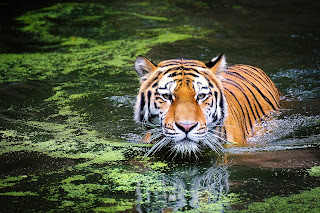Animal
Creatures (likewise alluded to as metazoa) are multicellular eukaryotic living beings that structure the organic realm Animalia. With barely any special cases, creatures expend natural material, inhale oxygen, can move, can recreate explicitly, and develop from an empty circle of cells, the blastula, during early stage advancement. Over 1.5 million living creature species have been portrayed—of which around 1 million are bugs—however it has been assessed there are more than 7 million creature species altogether. Creatures run long from 8.5 millionths of a meter to 33.6 meters (110 ft). They have complex associations with one another and their surroundings, framing perplexing food networks. The realm Animalia incorporates people, however in conversational use, the term creature regularly alludes just to non-human creatures. The logical investigation of creatures is known as zoology.
Most living creature species are in the Bilateria, a clade whose individuals have a reciprocally symmetric body plan. The Bilateria incorporate the protostomes—in which numerous gatherings of spineless creatures are discovered, for example, nematodes, arthropods, and molluscs—and the deuterostomes, containing both the echinoderms just as the chordates, the last containing the vertebrates. Life structures deciphered as early creatures were available in the Ediacaran biota of the late Precambrian. Numerous cutting edge creature phyla turned out to be obviously settled in the fossil record as marine species during the Cambrian blast, which started around 542 million years back. 6,331 gatherings of qualities basic to every single living creature have been recognized; these may have emerged from a solitary basic predecessor that lived 650 million years prior.
Generally, Aristotle partitioned creatures into those with blood and those without. Carl Linnaeus made the primary various leveled organic characterization for creatures in 1758 with his Systema Naturae, which Jean-Baptiste Lamarck ventured into 14 phyla by 1809. In 1874, Ernst Haeckel isolated the collective of animals into the multicellular Metazoa (equal for Animalia) and the Protozoa, single-celled living beings not, at this point thought about creatures. In present day times, the organic grouping of creatures depends on cutting edge strategies, for example, sub-atomic phylogenetics, which are powerful at exhibiting the developmental connections between creature taxa.
People utilize numerous other creature species, for example, for food (counting meat, milk, and eggs), for materials, (for example, cowhide and fleece), and furthermore as pets, and for transports, as working creatures. Mutts have been utilized in chasing, while numerous earthbound and oceanic creatures were pursued for sports. Non-human creatures have showed up in workmanship from the soonest times and are highlighted in folklore and religion.
"Animal" originates from the Latin animalis, which means having breath, having soul or living being.The organic definition incorporates all individuals from the realm Animalia. In conversational utilization, as a result of anthropocentrism, the term creature is once in a while utilized nonscientifically to allude just to non-human creatures.



Comments
Post a Comment